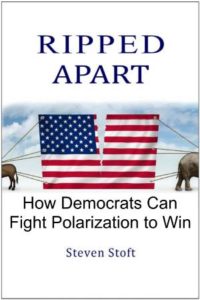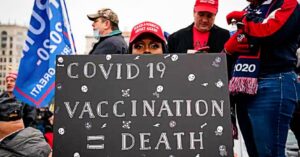1.3 Clear and Present Danger
I opened the doors to the Democratic Party and 20 million people walked out.
—George McGovern, 1972
Under the mistaken certainty of victory, shared by millions, Hillary Clinton signed a copy of Newsweek’s commemorative “Madam President” issue for a supporter. The next day, when Trump won the election, Newsweek’s distributor was forced to recall 125,000 copies that told of a hopeful future that was not to be.
Fifty years ago, Hubert Humphrey, one of our most liberal senators, lost a close election he should have won. Thousands of us refused to vote for him because he represented the Democratic establishment. He lost to Richard Nixon by 0.7%, and Nixon went on, four years later, to devastate the Democratic Party with his Southern Strategy and much help from the radical left. We still have not fully recovered.
Looking back, there’s no way to be sure that we radicals made the difference then, and the same is true today. But we do know that 12% of those who voted for Sanders in the primaries voted for Trump in November. Another 12% defected in other ways. (Of course, some of these were just conservatives who tried to mess with the Democratic primaries.)
The first 2020 danger we’ll look at is the chance that the parallels between 1968 and 2016 will continue. That would be devastating, but it’s entirely within our power to stop it. Then we’ll examine two strategic mistakes that are supporting what many predict will be Trump’s two central modes of attack during his 2020 campaign.
The Origin of Trump’s Base
Just as in 2016, something much bigger than the radical rejection of the establishment was going on in 1968. In 2016 it was Trump and in 1968 it was Trump’s doppelganger, George Wallace. That was the start of Trump’s base, and that matters because it warns us not to be lulled into thinking his base will soon disappear if we just take back the White House.
Wallace split off from the Democrats to form the American Independent Party and took a large slice of the White working-class with him. Here is Wallace, an avowed White supremacist, talking to the Northern working class in 1968 about a federal government with Democrats in charge:
They’ve looked down at the bus driver, the truck driver, the beautician, the fireman, the policeman, and the steelworker, the plumber.
Like Trump, he based his appeal on a culture war. His official slogan in 1968 was “Stand Up for America,” and his favorite catchphrase was “law and order” (still used by Trump), which targeted Blacks and antiwar protestors. He implied male hippies were sexual deviants, and he was proud of not being politically correct.
The parallels between Trump and Wallace are uncanny
Wallace was taking advantage of a working-class exodus from the Democratic Party partly caused partly by LBJ’s civil rights legislation but even more by school busing controversies. (Four months after passing civil rights, LBJ won an astounding landslide.) But this exodus was amplified by the left’s frequent expressions of hostility toward U.S. troops in Vietnam and toward America in general. This culture war is old and durable and will not yield to simple legislative fixes.
[Trump | Wallace image]
How Today’s Path Parallels the 1972 Disaster
As Yogi Berra would have said about our present party politics, “It’s déjà vu all over again.” And he would’ve been talkin’ about how Obama, Clinton, and some radical candidate could parallel LBJ, Humphrey, and McGovern.
In 1964, Lyndon Johnson won his historic landslide victory by 23%, striking a decisive blow against the conservatism of Barry Goldwater and ratifying the triumph of the Kennedy-Johnson Civil Rights Bill. But a mere four years later, the 1968 Democratic National Convention paralleled the 2016 Convention in its divisiveness.
By ‘68, LBJ’s Vietnam War was killing more than 1,000 young men a month, so we pushed him aside. But he engineered Vice President Humphrey’s nomination without Humphrey running in even a single primary, let alone winning one. The nomination was rigged, and the convention floor was rowdy, to say the least.
After that convention, some of us said, “Good luck without us,” as did some Berniecrats in 2016. I voted for Dick Gregory, a radical Black comedian. Humphrey lost the 1968 race to Richard Nixon by a hair.
The breadth and fury of our resistance to Nixon may well have outdone our present resistance to Trump. In November 1969, massive demonstrations were held at the White House and in San Francisco. In May 1970, at Kent State University, four antiwar protesters were killed by the National Guard. Huge May Day protests in 1970 were met with 10,000 troops, ordered by Nixon to join 7,000 police, who arrested 12,000 protesters.
The parallel also holds within the Democratic Party. George McGovern had been one of the antiwar/anti-establishment candidates who lost to Humphrey at the contentious 1968 convention, as Sanders lost to Clinton in 2016. But Humphrey’s loss gave McGovern and his young progressives the upper hand in the Party, and they rewrote the Party rules, much like what’s been done for 2020. The McGovern forces used their rule changes to win his nomination.
After four years of unprecedented resistance to Nixon, we were optimistic. But McGovern lost in 49 states, ending all talk of “The Revolution.” McGovern summed up Democratic losses from 1964 to 1972 with brutal honesty: “I opened the doors to the Democratic Party and 20 million people walked out.”
Dangerous Approaches to the Culture War
Besides the danger of McGovern redux, we are helping Trump with his two major lines of attack—immigration and socialism. We like to flaunt the U.S. becoming a majority-minority country, where the majority consists of people of color. And we call ourselves “socialists” although we’re not. Both strike fear in the hearts of his base, and both anger them, unify them and make them stronger. That’s just as dangerous as our infighting
The most popular political book of 2002, The Emerging Democratic Majority , explained that the increase in the Mexican-American population would lead inevitably to a permanent Democratic majority. The 1986 Immigration Act had allowed 2.3 million Mexicans who had immigrated illegally to become citizens, and then we broke our promise of tight border controls, setting up a repeat. Trump’s base drew the obvious conclusion: We rigged the system against them to take away the country as they knew it. (No, I’m not saying that was our intention; I’m saying we need to understand how they see it, to avoid adding fuel to Trump’s fire.)
Likewise with socialism. Virtually all of the Democrats calling themselves socialists, as we will see later, are really only advocating FDR liberalism—even according to Sanders. So why adopt what amounts to the right-wing definition of socialist and then incorrectly call ourselves socialists as the red-baiters always have? Just to outrage conservatives? Of course, Trump just loves the idea of running against a socialist. (In Chapter 23 we’ll discover the real reason behind Sanders’ ploy.)
These two dangers were pointed out in early 2019 by presidential biographer Jon Meacham and by Ian Bremmer, a political scientist known for political risk assessment. Both put special emphasis on the “socialism” risk.
My point is a simple one: There’s plenty that we care about that they won’t like. So why go out of our way to make them feel attacked? Attacks, real or perceived, only increase Trump’s base’s desire for a strongman. Either we understand this or risk losing.
A House Divided Against Itself …
The 1972 election was a disaster for many reasons, but the one that is most relevant today is how the Democratic Party treated the White working class.
The radical wing of the party, which supported McGovern, made rule changes before the 1972 convention that cut sharply against working-class representation. State delegations were required to meet quotas for minorities, women, and young people, but the quotas did not require labor or working-class representation. The radical left (and I was among them) distrusted the working class for being generally pro-war and sometimes racist.
McGovern’s followers found that Mayor Daley’s Chicago delegation did not reflect the new progressive quotas, so they put together their own unelected delegation, which successfully challenged Daley’s. The Mayor and his 59 delegates were ejected from the convention and replaced with a delegation led by Jesse Jackson, the leader of what he called the “Rainbow Coalition,” a name borrowed from the Black Panthers.
A columnist for the Chicago Sun-Times noted, “There’s only one Italian there [in the Jackson delegation]. Are you saying that only one out of every 59 Democratic votes cast in a Chicago election is cast by an Italian? … Your reforms have disenfranchised Chicago’s White ethnic [working-class] Democrats.” That election was the only time the AFL-CIO did not endorse the Democratic candidate for president and the only time Republicans won the union vote. That was absolutely due to the radical left.
As noted above, More in Common identified a group of radical activists who now play a similar role in the Democratic Party to McGovern’s supporters. Just as was true back then, today’s radical activists are better off and better educated than the average American, and also more ideological and less concerned with jobs and healthcare than any other political tribe, from left to right.
The radical left constantly blames the liberals—calling them “neoliberals”—for losing the White working class. But this is just a divisive cover for their own role. And it’s highly polarizing.
Conclusion
Boasting of our eventual majority-minority victory or our radically righteous “socialism” can raise some of our spirits temporarily. But this shortsighted gain is both self-deceiving and self-defeating.
Worse yet are the intra-party attacks, especially those on the party’s liberal base. These weaken us and keep us ignorant of the crucial lessons that we need to learn from past mistakes.
This is not the time for grandstanding or for moralistic accusations against our own people. We all share the same broad goals of fairness and greater equality and work hard in ways that match our diverse communities.
To achieve the country we want, we must fight polarization in our party and the country.
- Claiming we’re stronger and better only makes us weaker and less deserving of respect.
- All Democrats share the same broad goals. We just have different views on how to get there.

 Ripped Apart
Ripped Apart

